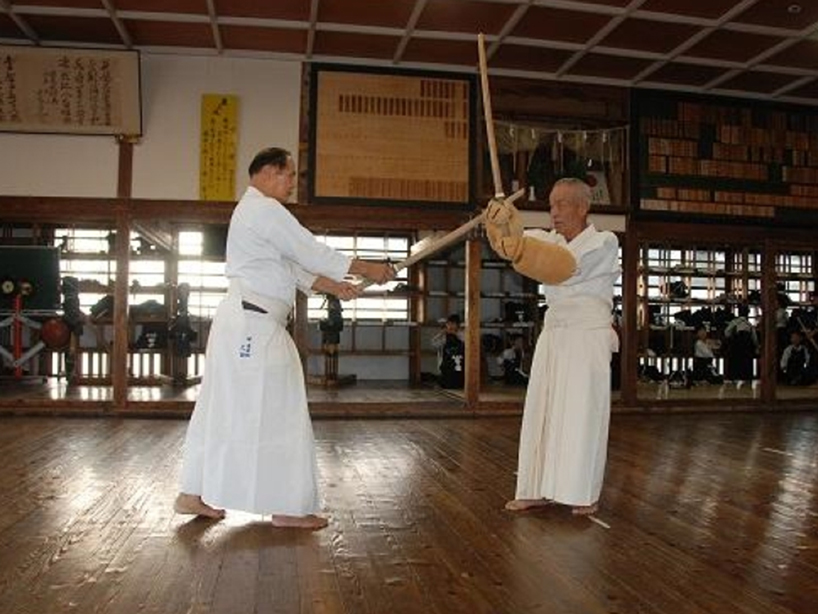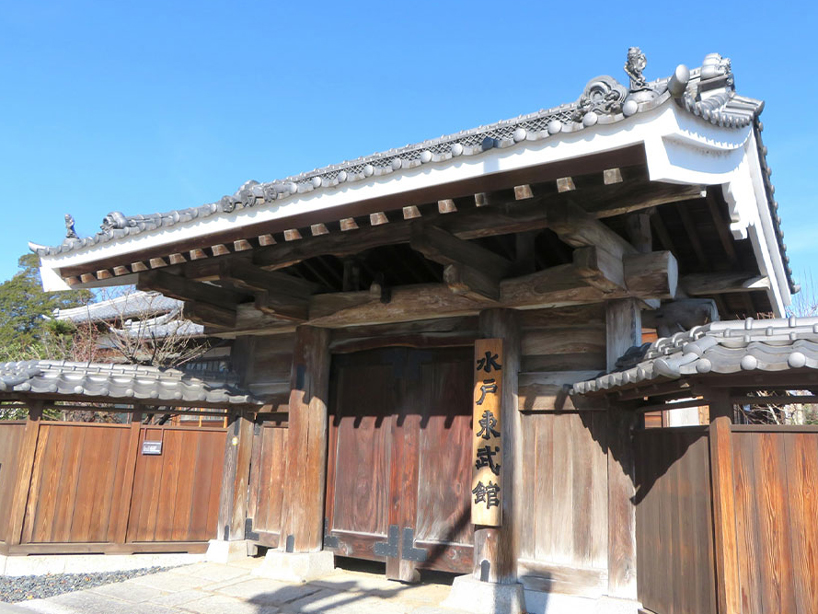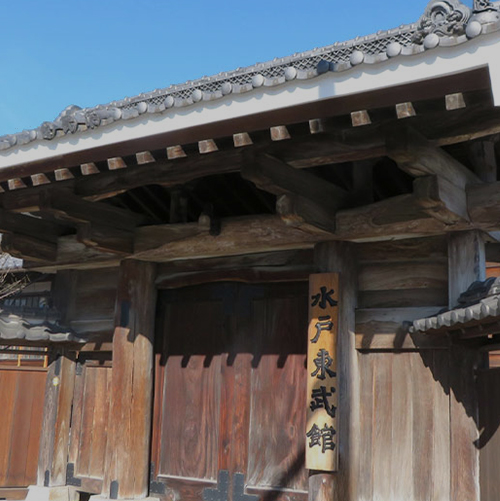GUIDE01
水戸東武館
Mito Tobukan
水戸東武館は、1832年の創設以来の「文武不岐」の精神のもとに、日本の伝統文化である剣道、なぎなた道・居合道の修練を重ね、これを正しく後世に伝承するための修練に努める道場です。
Since its founding in 1832, Mito Tobukan has been a dojo that has practiced the traditional Japanese arts of kendo, naginata-do, and iaido under the spirit of "bunbu fuki" (the arts and martial arts are one and the same), striving to pass these arts on correctly to future generations.

幕末の剣豪、千葉周作が創始した「北辰一刀流」。江戸の千葉道場は6千人余りの門弟をかかえ、坂本龍馬が剣の腕を磨いたことでも知られます。「北辰一刀流」は水戸藩に伝わったことから、今も水戸市の無形文化財として継承されています。
「北辰一刀流」の鍛錬された演武は、観る者を圧倒します。
Hokushin Itto-ryu was founded by Chiba Shusaku, a master swordsman at the end of the Edo period. The Chiba Dojo in Edo had over 6,000 disciples, and is known as the place where Sakamoto Ryoma honed his swordsmanship. Hokushin Itto-ryu was passed down to the Mito Domain, and is still preserved as an intangible cultural asset of Mito City.
The well-trained demonstrations of Hokushin Itto-ryu leave spectators awed.

<もっと知りたい!深掘り>
~水戸藩校弘道館と水戸東武館~
I want to know more! Digging deeper
~Mito Domain School Kodokan and Mito Tobukan~
水戸東武館 館長
高山 陽好
Director of Mito Tobukan
Takayama Yoko
水戸城大手門が再建され、水戸一高がある本丸から水戸警察署北側の土塁、空堀にかけての一帯は水戸城址風致地区としてさらにグレードアップし、偕楽園と並んで水戸観光の目玉となっている。その中でも中心的存在になっているのが、国の特別史跡でかつ日本遺産に指定されている旧水戸藩校の弘道館である。
弘道館は第九代藩主徳川斉昭が、停滞した社会、行き詰まった行政を打開して国家の存立を全うするためには真の日本人を育成する必要であるとの自覚に基づき、藤田東湖や会沢正志斎などの優れた学者の意見を用いて1841年(天保12年)に創設したものである。その教育の精神は弘道館記に明記されている通り、忠孝無二・文武不岐・学業一致の3つである。とくに斉昭は「文武は武士の大道にして人々出精すべきこと」と示唆しているように文武兼備の人物の育成に力を注いだとされる。
ここでは武道の中の剣術について取り上げたい。弘道館の剣術は、水府流(水戸藩独自で各流派の長所を取り入れ編み出した剣術)北辰一刀流、神道無念流の3流が、現三の丸小学校敷地に設置された3か所の剣術道場において訓練されていた。「朝文夕武の法」と称した教育方針に基づいて、剣術は正午から午後4時まで行われていたと記憶にある。
北辰一刀流の元祖千葉習作は斉昭公からの招請を受け、子息とともに来水し弘道館正庁南に位置する対試場でその剣術を披露した。抜群の力量が高く評価され、最終的には馬廻役百石で召抱えとなり剣術指南役として活躍することとなった。
千葉の教え子の一人に小澤寅吉がいた。彼は若くして北辰一刀流の大目録皆伝を許され、矢倉奉行の役と剣術指南役を務めた逸材であった。千葉が水戸を去った後は、北辰一刀流の第一人者として弘道館での剣術指南に尽力したのである。
明治維新はその名のとおり政治、社会を一変させた。幕藩体制と武士階級の消滅により弘道館も1872年(明治5年)閉校となり、人づくりによる国家護持という建学の精神も終焉を迎えたのである。前述の小澤寅吉は明治7年、廃れゆく武士道精神、武道の衰退を憂い、剣道(明治初期に剣術から改称)の振興と人材の育成を目指して田見小路(現北見町)の自邸内に町道場水戸東武館を創設した。弘道館の文武不岐の精神と北辰一刀流の剣理に基づく指導により、この道場からは、現代剣道の礎を築いた内藤高治、門奈正などの名剣士が世に送り出されて、天下にその名を大いに轟かせたのである。
昭和20年、戦災により道場焼失、占領軍による武道禁止という大打撃を受けた水戸東武館であったが、昭和28年4代館長小澤武は、現道場を再建、剣道による青少年育成を再開(小生は小3生で入館)全国少年剣道大会を開催するなど剣道の隆盛に尽力した。
平成25年、道場の本館と正門などが水戸市有形文化財、北辰一刀流と新田宮流抜刀術が同無形文化財の指定を受けた。また平成27年に道場を現在地に移築して市の風致地区へ仲間入りしたところである。今日、茨城県、水戸市などによる弘道館とのタイアップ広報効果もあって、外国人、企業幹部などの武道体験希望も多い。
Mito Castle’s Otemon Gate has been reconstructed, and the area stretching from the honmaru (inner bailey), where Mito First High School is located, to the earthen embankment and dry moat north of the Mito Police Station, has been further enhanced as the Mito Castle Site Scenic Area. Alongside Kairakuen, it has become one of Mito’s premier tourist destinations. At the heart of this area stands the Kodokan, a former Mito domain school designated both as a Special Historic Site by the national government and as part of Japan Heritage.
The Kodokan was founded in 1841 (Tenpō 12) by the ninth Mito domain lord, Tokugawa Nariaki. Confronting a stagnant society and an administration at an impasse, Nariaki believed that cultivating truly capable Japanese was essential to safeguard the nation. He incorporated the advice of distinguished scholars such as Fujita Tōko and Aizawa Seishisai. The Kodokan’s educational principles were explicitly stated in the “Kodokan Ki”: (1) chūkō muni (loyalty and filial piety as one), (2) bunbu fuki (the unity of literary and martial arts), and (3) gakugei itchi (the integration of academic study and practical skills). Nariaki, in particular, placed great emphasis on developing individuals proficient in both literary and martial pursuits, as evidenced by his remark that “the literary and martial arts are the great paths of the samurai, and everyone should strive for excellence in both.”
Among the martial arts, this text focuses on swordsmanship. At the Kodokan, three schools of kenjutsu—Suifu-ryū (a unique Mito domain style formed by integrating the strengths of various schools), Hokushin Ittō-ryū, and Shindō Munen-ryū—were practiced at three separate dōjō located on what is now the site of Sannomaru Elementary School. Following an educational policy referred to as “chōbun sekibu no hō” (study in the morning, train in the evening), swordsmanship training was conducted daily from noon to 4:00 p.m., if memory serves.
Chiba Shūsaku, founder of Hokushin Ittō-ryū, was invited to Mito by Lord Nariaki. Together with his sons, he demonstrated his swordsmanship at the Taishijō area located south of the Kodokan’s main hall. Impressed by his extraordinary skill, the domain awarded him a stipend of 100 koku and employed him as both a retainer and a kenjutsu instructor.
One of Chiba’s students was Ozawa Torakichi. Despite his youth, Ozawa earned the full instructor’s license (ōmokuroku menkyo kaiden) in Hokushin Ittō-ryū and served as both yagura bugyō (watchtower magistrate) and kenjutsu instructor. After Chiba left Mito, Ozawa worked tirelessly as Hokushin Ittō-ryū’s foremost instructor at the Kodokan.
The Meiji Restoration brought about dramatic changes in politics and society. With the abolition of the feudal domain system and the samurai class, the Kodokan closed its doors in 1872 (Meiji 5), and its mission—protecting the nation through human development—came to an end. In 1874 (Meiji 7), Ozawa Torakichi, worried about the decline of bushidō ideals and the waning of martial arts, established a private dōjō called Mito Tōbukan at his residence on Tami-kōji (present-day Kitami-chō). There he promoted kendo (the name given to kenjutsu in the early Meiji period) and worked to train the next generation. Emphasizing Kodokan’s bunbu fuki ethos and the principles of Hokushin Ittō-ryū, the dōjō produced many renowned swordsmen who laid the foundations of modern kendo, including Naitō Kōji and Monna Masashige. Their achievements garnered national recognition.
In 1945 (Shōwa 20), Mito Tōbukan was destroyed by fire during the war and later suffered under the Allied Occupation’s ban on martial arts. In 1953 (Shōwa 28), however, Ozawa Takeshi, the fourth head of the dōjō, rebuilt it and resumed the work of youth development through kendo. (I myself joined as a third-grader.) He also organized national youth kendo tournaments, contributing significantly to the resurgence of the art.
In 2013 (Heisei 25), the dōjō’s main building, front gate, and other structures were designated as Tangible Cultural Properties by the City of Mito. At the same time, Hokushin Ittō-ryū and Shinden Tamiya-ryū battōjutsu were designated as Intangible Cultural Properties. Two years later, in 2015 (Heisei 27), the dōjō was relocated to its current site, becoming part of the city’s scenic area. Thanks in large part to promotional efforts alongside the Kodokan by Ibaraki Prefecture and Mito City, the dōjō now attracts numerous visitors—foreign tourists as well as corporate executives—eager to experience Japanese martial arts.
GUIDE 02 /鰻亭(ばんてい)
GUIDE 02 /Bantei
INDEX /ツアートップ
INDEX /Tour Top
 関東エリアバス観光ガイド
Kanto Area Bus Tourist Guide
関東エリアバス観光ガイド
Kanto Area Bus Tourist Guide

滞在時間11:00-12:00
Length of Stay11:00-12:00

